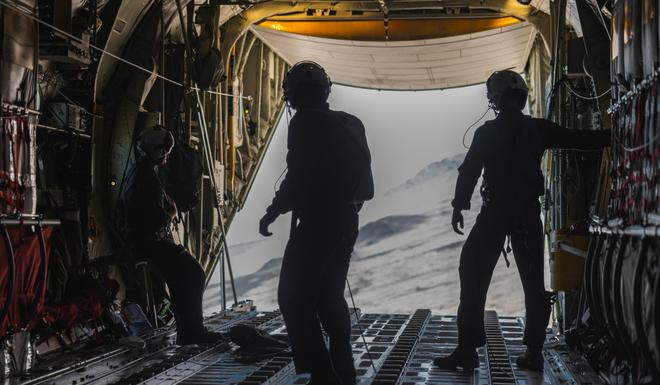Published 09:11 IST, June 26th 2024
U.S. Marines Achieve First KC-130J Landing on Renovated WWII Airfield amid Pacific Defense Upgrade
The Peleliu landing underscores US efforts to integrate airpower across vast distances, adapting military strategies to current geopolitical challenges.

Peleliu, Republic of Palau: U.S. military operations in the Pacific achieved a significant milestone on Saturday after the Marines successfully landed a KC-130J Super Hercules tanker on the recertified airfield of Peleliu. This historic landing is the first of its kind since the Marine Corps recertified the airfield earlier in June, according to a Marine Corps press release.
The Marine Corps Engineer Detachment Palau, specifically MCED-P 24.1, comprised of engineers from the 7th Engineer Support Battalion, 1st Marine Logistics Group, played a crucial role. Over the past months, they diligently rehabilitated the airfield to enable the safe landing of large, fixed-wing aircraft like the KC-130J.
“I feel privileged because I was in Peleliu in 2021 and saw the airfield transform into what it is now,” said Sgt. Brandon Gonzalez, combat engineer squad leader. He led efforts in vegetation removal and assisted in sweeping for unexploded ordnance. “It truly is an honour to have been a part of this mission and see it come to fruition with a KC-130 landing.”
Strategic Significance and Regional Reach
The recertified airfield now positions Marine aircraft within 1,000 miles of Manila, Philippines, a key Pacific partner nation for the United States. Peleliu is approximately 1,400 miles from Okinawa, Japan, home to the 3rd Marine Division and a significant U.S. Marine presence in the region. Guam, slated to host a new Marine littoral regiment, lies about 1,500 miles southwest of the Philippines, further enhancing regional military capabilities.

“Today is a historic moment as we land a Marine Corps aircraft on the ‘Sledge’ runway,” remarked Maj. Christopher Romero, Commanding Officer of Marine Corps Engineer Detachment Palau. The runway’s “Sledge” title honours Pfc. Eugene Sledge, a veteran of the Battle of Peleliu and author of “With the Old Breed: At Peleliu and Okinawa,” a seminal Marine Corps memoir.
Heightened Tensions in the South China Sea
As the 80th anniversary of the Battle of Peleliu approaches this September, the Marines are pioneering new methods to integrate airpower across the vast Pacific distances. This initiative marks a departure from the operational focus seen during previous conflicts in Iraq and Afghanistan. Ongoing upgrades and expansions in Guam, Tinian, and Saipan underscore the evolving military strategy in the region.
Commandant Gen. Eric Smith, in a 2024 congressional hearing, highlighted ongoing experiments with durable, quick-installation matting for airstrips, enhancing flexibility in deploying air assets. Concurrently, the Air Force’s $400 million upgrade to Yap Island’s airfield in the Federated States of Micronesia reflects broader regional military developments.

This strategic military manoeuvring comes amid heightened tensions in the South China Sea, where the Philippines recently faced a clash with Chinese coast guard forces. President Ferdinand Marcos Jr. condemned the incident, asserting Philippine sovereignty while awarding medals to navy personnel involved in the confrontation at Second Thomas Shoal.
The clash underscores ongoing disputes over maritime boundaries, with China asserting territorial claims rejected by international arbitrators and rival claimants alike. As tensions persist, regional military activities continue to shape geopolitical dynamics in the Indo-Pacific.
Updated 09:11 IST, June 26th 2024


